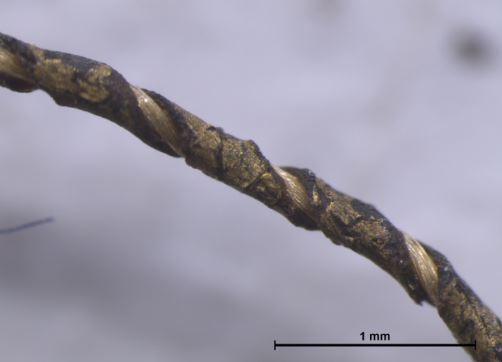User Group Leader: Cristina Scibè
https://bellasartes.us.es/en
Venue: ATOMKI , Debrecen, Hungary
Since ancient times, golden threads have been woven into textiles and used for embroidering clothes to create luxurious objects. Gilding and silvering techniques have undergone through a specific evolution; thus, different metal coating technologies can be related to a given historical period and textile manufacturing center. Between the 11th and the 14th century, gilt and silvered organic strips were among the metal threads most commonly used in European and Middle Eastern textiles, either as flat strips or wound around a fibrous core (composite threads). In these types of threads, the metal coating (powder or leaf) was applied in one or multiple thin layers with the help of a binding medium (animal glue, egg, or bole) on the organic substrate (made with animal skin, animal gut or membrane and paper) that made up most of the thickness of the thread.
The main objective of the METHIT project was to reveal the micro-chemical nature (elemental composition and structure) of the threads by applying micro-PIXE that could be used to determine different production technologies and could contribute to a more exact dating and geographical assignment of Spanish and Italian medieval metal threaded textiles.
A series of 45 samples taken out of 42 textiles from the Museo Civico di Arte of Modena- CG (Italy), the Centre de Documentacio i Museu Textil of Terrassa- CDMT (Spain), and the Museo del Tessuto of Prato- MTP (Italy), were investigated to characterize metal threads by PIXE and RBS techniques. The samples were selected according to the textile provenance (Spain or Italy, both those of known origin and uncertain origin) and dating (from the 11th to the 15th century). Three types of composite metal threads have been studied: solid metal flattened strips wound around a silk core (17 samples), metal-coated membrane strips wound around a linen core (14 samples), and metal-coated skin strips wound around a silk or a linen core (14 samples).
In the framework of the METHIT project, PIXE and RBS measurements were carried out in vacuum at the ATOMKI scanning nuclear microprobe with a proton beam of 3.2 MeV energy and a current of 200-300 pA. PIXE elemental maps were recorded in two different modes: full scan of the sample and selected homogeneous areas 1 mm2 scan size depending of the sample, in order to reveal the main (Au and Ag), minor and tracer constituents (Cu, Hg, Pb, Ni, Zn, Bi, Ti, Mn and Cr) elemental distribution and to identify technological features. The significant content of Ca, S, and Cl in some metal threads made by an organic substrate were related to the substrate composition and treatment. At the first analytical evaluation, the most significant result is the identification of trace elements of archaeological interest, as they are extremely useful for relating different metal compositions with different metal sources and for production technologies.
The obtained results will be published in an archaeological journal and presented at a conference.

